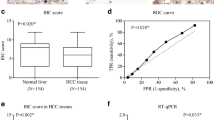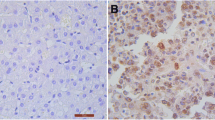Abstract
Background
Hepatocellular carcinoma (HCC) accounts for 75–80 % of primary liver cancer, and usually arises after years of liver disease. Thus it is important to understand the molecular mechanisms which drive or mediate the development of HCC.
Aim
In this work, we examined whether CD109 was associated with a poor prognosis in HCC and explored possible underlying mechanisms.
Methods
We examined the CD109 and Ki67 expression levels in 97 patients with HCC using immunohistochemistry. CD109 levels in HCC cells were down-regulated by shRNA transfection. The cycle progression and cell proliferation status of HCC cells were evaluated by flow cytometry and CCK-8 assay. The effect of CD109 on proliferation and apoptosis was investigated by western blot and TUNEL activity assays.
Results
The CD109 protein was up-regulated in HCC tissue compared with adjacent noncancerous tissue. CD109 expression levels in the 97 patients with HCC were positively correlated with histological grade. Univariate and multivariate survival analysis revealed that CD109 was a significant predictor of overall survival among HCC patients. CD109 shRNA knockdown delayed the G1–S phase transition, abrogated cell proliferation, and increased cell apoptosis. Furthermore, CD109 impaired TGF-β/Smad signaling through control of p-smad2.
Conclusions
CD109 promoted HCC proliferation and predicted poor prognosis. In addition, CD109 expression was associated with anti-apoptosis in HCC cells.







Similar content being viewed by others
Change history
11 November 2019
This article [1] is retracted at the request of Editor-in-Chief.
References
Tsao CM, et al. SOX1 functions as a tumor suppressor by antagonizing the WNT/beta-catenin signaling pathway in hepatocellular carcinoma. Hepatology. 2012;56:2277–2287.
Cheng AS, et al. EZH2-mediated concordant repression of Wnt antagonists promotes beta-catenin-dependent hepatocarcinogenesis. Cancer Res. 2011;71:4028–4039.
Zhang J, et al. Cancer specific long noncoding RNAs show differential expression patterns and competing endogenous RNA potential in hepatocellular carcinoma. PLoS One. 2015;10:e0141042.
Hagikura M, et al. Correlation of pathological grade and tumor stage of urothelial carcinomas with CD109 expression. Pathol Int. 2010;60:735–743.
Lin M, et al. Cell surface antigen CD109 is a novel member of the alpha(2) macroglobulin/C3, C4, C5 family of thioester-containing proteins. Blood. 2002;99:1683–1691.
Hashimoto M, et al. Expression of CD109 in human cancer. Oncogene. 2004;23:3716–3720.
Beije N, et al. Prognostic value and kinetics of circulating endothelial cells in patients with recurrent glioblastoma randomised to bevacizumab plus lomustine, bevacizumab single agent or lomustine single agent. A report from the Dutch Neuro-Oncology Group BELOB trial. Br J Cancer. 2015;113:226–231.
Hwang SM, et al. Human platelet antigen genotyping and expression of CD109 (human platelet antigen 15) mRNA in various human cell types. Biomed Res Int. 2013;2013:946403.
Hagiwara S, et al. Processing of CD109 by furin and its role in the regulation of TGF-beta signaling. Oncogene. 2010;29:2181–2191.
Chan KS, et al. Identification, molecular characterization, clinical prognosis, and therapeutic targeting of human bladder tumor-initiating cells. Proc Natl Acad Sci USA. 2009;106:14016–14021.
Ohshima Y, et al. CD109 expression levels in malignant melanoma. J Dermatol Sci. 2010;57:140–142.
Cuppini L, et al. Prognostic value of CD109+ circulating endothelial cells in recurrent glioblastomas treated with bevacizumab and irinotecan. PLoS One. 2013;8:e74345.
Xu Z, et al. USP11, deubiquitinating enzyme, associated with neuronal apoptosis following intracerebral hemorrhage. J Mol Neurosci. 2016;58:16–27.
Xu Z, et al. Upregulated expression of karyopherin alpha2 is involved in neuronal apoptosis following intracerebral hemorrhage in adult rats. Cell Mol Neurobiol. 2015. [Epub ahead of print]. doi:10.1007/s10571-015-0258-7.
Zhang S, et al. Overexpression of SYF2 correlates with enhanced cell growth and poor prognosis in human hepatocellular carcinoma. Mol Cell Biochem. 2015;410:1–9.
Sciarra A, et al. Morphophenotypic changes in human multistep hepatocarcinogenesis with translational implications. J Hepatol. 2016;64:87–93.
Tan HY, et al. Autophagy-induced RelB/p52 activation mediates tumour-associated macrophage repolarisation and suppression of hepatocellular carcinoma by natural compound baicalin. Cell Death Dis. 2015;6:e1942.
Zhang F, et al. SWATH- and iTRAQ-based quantitative proteomic analyses reveal an overexpression and biological relevance of CD109 in advanced NSCLC. J Proteomics. 2014;102:125–136.
Dong F, et al. CD109 expression is increased in cutaneous squamous cell carcinoma. J Dermatol. 2014;41:947–949.
Zhang JM, et al. CD109 attenuates TGF-beta1 signaling and enhances EGF signaling in SK-MG-1 human glioblastoma cells. Biochem Biophys Res Commun. 2015;459:252–258.
Winocour S, et al. CD109, a novel TGF-beta antagonist, decreases fibrotic responses in a hypoxic wound model. Exp Dermatol. 2014;23:475–479.
Bizet AA, et al. CD109-mediated degradation of TGF-beta receptors and inhibition of TGF-beta responses involve regulation of SMAD7 and Smurf2 localization and function. J Cell Biochem. 2012;113:238–246.
Bizet AA, et al. The TGF-beta co-receptor, CD109, promotes internalization and degradation of TGF-beta receptors. Biochim Biophys Acta. 2011;1813:742–753.
Yan HH, et al. CCL9 induced by TGF-beta signaling in myeloid cells enhances tumor cell survival in the premetastatic organ. Cancer Res. 2015;75:5283–5298.
Wang XH, et al. TGF-beta1 pathway affects the protein expression of many signaling pathways, markers of liver cancer stem cells, cytokeratins, and TERT in liver cancer HepG cells. Tumour Biol. 2015. [Epub ahead of print].
Riemenschneider MJ, et al. TGF-ss isoforms in cancer: immunohistochemical expression and Smad-pathway-activity-analysis in thirteen major tumor types with a critical appraisal of antibody specificity and immunohistochemistry assay validity. Oncotarget. 2015;6:26770–26781.
Dong F, et al. CD109 is a novel marker for squamous cell/adenosquamous carcinomas of the gallbladder. Diagn Pathol. 2015;10:137.
Litvinov IV, et al. CD109 release from the cell surface in human keratinocytes regulates TGF-beta receptor expression, TGF-beta signalling and STAT3 activation: relevance to psoriasis. Exp Dermatol. 2011;20:627–632.
van den Hoogen C, et al. High aldehyde dehydrogenase activity identifies tumor-initiating and metastasis-initiating cells in human prostate cancer. Cancer Res. 2010;70:5163–5173.
Acknowledgments
This work was supported by the National Basic Research Program of China (973 Program, No. 2012CB822104), the National Natural Science Foundation of China (No. 81202368), Technology Innovation Program of Nantong University (YKC14055, YKC15052), Technology Innovation Program of Jiangsu Province (KYZZ15_0351), and a project funded by the Priority Academic Program Development of Jiangsu Higher Education Institutions (PAPD).
Author information
Authors and Affiliations
Corresponding authors
Ethics declarations
Conflict of interest
The authors declare that they have no conflict of interest.
Additional information
Guijuan Zong and Zhiwei Xu have contributed equally to this work.
This article [1] is retracted at the request of Editor-in-Chief.
The GAPDH band in Figure 1A and Figure 5A in [1] appear to be duplicated from Figure 4A in [2].
The PCNA and p27 bands in Figure 4D in [1] appear to be duplicated from portions of Figure 4A in [3] and Figure 1A in [2].
The bands in Figure 1A, 4D and 4D [1] appear to be identical.
Figure 7B in [1] appears to be duplicated from [4].
This article contains substantial text overlap with [5-10].
All authors agree to this retraction.
[1] Guijuan Zong, Zhiwei Xu, Shusen Zhang, Yifen Shen, Huiyuan Qiu, Guizhou Zhu, Song He, Tao Tao and Xudong Chen . CD109 Mediates Cell Survival in Hepatocellular Carcinoma Cells Digestive Diseases and Sciences (2016) 61: 2303-2314 https://link.springer.com/article/10.1007/s10620-016-4149-7
[2] Xiaohong Wu, Haiyan Zhang, Dongjian Chen, Yan Song, Rong Qian, Chen Chen, Xingxing Mao, Xinlei Chen, Weidong Zhang, Bai Shao, Jianhong Shen, Yaohua Yan, Xinmin Wu, Yonghua Liu. (2015) Up-Regulation of CCT8 Related to Neuronal Apoptosis after Traumatic Brain Injury in Adult Rats. Neurochem Res.40,1882–1891 https://link.springer.com/article/10.1007%2Fs11064-015-1683-1
[3] Haiyan Zhang, Yonghua Liu, Yao Li, Ying Zhou, Dongjian Chen, Jianhong Shen, Yaohua Yan, Song Yan, Xinmin Wu, Aihong Li, Aisong Guo, Chun Cheng (2014) The Expression of CAP1 After Traumatic Brain Injury and Its Role in Astrocyte Proliferation. Journal of Molecular Neuroscience. 54:4, 653-663. https://link.springer.com/article/10.1007/s12031-014-0363-y
[4] Zhiwei Xu, Xiaohong Li, Jianping Chen, Jianmei Zhao, Jun Wang, Yuhong Ji, Yifen Shen, Lijian Han Jiansheng Shi, Dongmei Zhang (2016) USP11, Deubiquitinating Enzyme, Associated with Neuronal Apoptosis Following Intracerebral Hemorrhage. 58:1, 16-27. https://link.springer.com/article/10.1007/s12031-015-0644-0
[5] Hong-Wei Chen, Xiao-Dong Huang, Hong‐Chen Li, Song He, Run-Zhou Ni, Cui-Hua Chen, Chen Peng, Gang Wu, Gui-Hua Wang, Ying-Ying Wang, Yun-Hong Zhao, Yi-Xin Zhang, Ai-Guo Shen, Hui-Min Wang (2012) Expression of FOXJI in Hepatocellular Carcinoma: Correlation with Patient’s Prognosis and Tumor Cell Proliferation Molecular Carcinogenesis. 641-659 https://onlinelibrary.wiley.com/doi/abs/10.1002/mc.21904
[6] Cuihua Lu, Guoliang Liu, Xiaopeng Cui, Jing Zhang, Lixian Wei, Yingying Wang, Xiaojing Yang, Yanhua Liu, Xia Cong, Liting Ly, Runzhou Ni, Xiaodong Huang (2013) Expression of SGTA Correlates with Prognosis and Tumor Cell Proliferation in Human Hepatocelluar Carcinoma Pathology and Oncology Research. Pathology and Oncology Research. 51-60 https://link.springer.com/article/10.1007/s12253-013-9657-6
[7] Xiaodong Huang, Xingxiu Wang, Chun Cheng, Jing Cai, Song He, Hua Wang, Fang Liu, Changlai Zhu, Zongmei Ding, Xianting Huang, Tianyi Zhang Chaperonin containing TCP1, subunit 8 (CCT8) is upregulated in hepatocellular carcinoma and promotes HCC proliferation (2014) APMIS. 1070-1079. https://onlinelibrary.wiley.com/doi/abs/10.1111/apm.12258
[8] GuizhouZhu, WeidongShi, HuiFan, XiubingZhang, JianXu, YongmeiChen, ZhiweiXu, TaoTao, ChunCheng, (2015) HES5 Promotes Cell Proliferation and Invasion through Activation of STAT3 and Predicts Poor Survival. Experimental and Molecular Pathology (2015) 474-484 https://www.sciencedirect.com/science/article/abs/pii/S0014480015001860
[9] Ting Zhu, Zhengxiang Ji, Caixia Xu, Zhiyang Peng, Liang Gu, Rui Zhang, Yangchen Liu (2014) Expression and Prognostic Role of SKIP in Human Breast Carcinoma. Journal of Molecular Histology (2014) 169-180 https://link.springer.com/article/10.1007%2Fs10735-014-9586-z
[10] Tingting Zhang, Xiubing Zhang, ,Weidong Shi, Jian Xu,, Hui Fan, Shusen Zhang, Runzhou Ni (2016) The DNA Damage Repair Protein Ku70 Regulates Tumor Cell and Hepatic Carcinogensis by Interacting with FOX04. Pathology Research and Practice. https://www.sciencedirect.com/science/article/pii/S0344033815300649?via%3Dihub
Electronic supplementary material
Below is the link to the electronic supplementary material.
About this article
Cite this article
Zong, G., Xu, Z., Zhang, S. et al. RETRACTED ARTICLE: CD109 Mediates Cell Survival in Hepatocellular Carcinoma Cells. Dig Dis Sci 61, 2303–2314 (2016). https://doi.org/10.1007/s10620-016-4149-7
Received:
Accepted:
Published:
Issue Date:
DOI: https://doi.org/10.1007/s10620-016-4149-7




